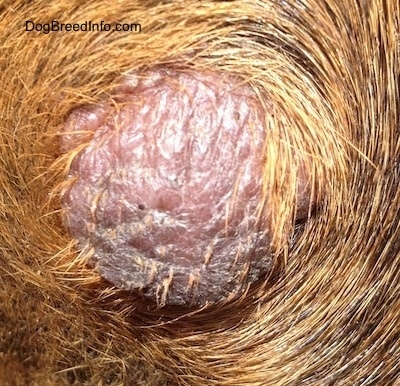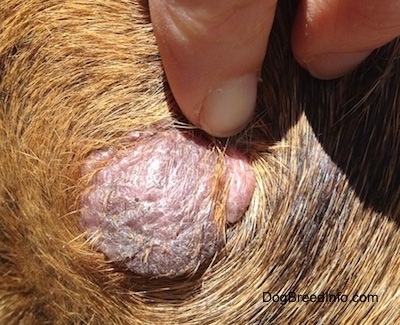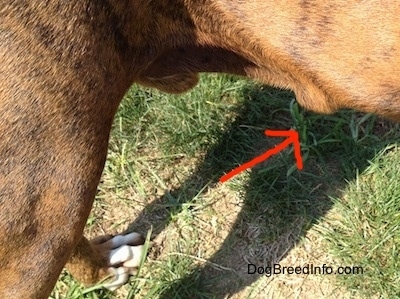
Cancerous mast cell tumor above the skin.
Mast cells originate from the bone marrow and can be found throughout the body's connective tissue. They are normal components of the immune system, but can form into growths called mast cell tumorsn (MCT). About 20% of tumors in dogs are mast cell tumors, a type of tumor consisting of mast cells. Some mast cell tumors are malignant cancer, but some are benign. The tumors release high levels of histamine into the body. Mast cells also respond to tissue trauma. If you push on the tumor sight you can actually aggravate the tumor causing it to spore out and spread in other parts of the body. Mast cell granules contain histamine, heparin, platelet-activating factor, and other substances. The chemicals the mast cell releases into the body can cause itching, gastric ulcers, flatulence, allergic reactions, loss of appetite, vomiting, diarrhea, anemia and internal bleeding.
The tumor has deep roots. When they are removed about 3cm around the tumor must be taken out. For malignant tumors the borders around the tumor are biopsied to see if the edges are clean (cancer free).

Cancerous mast cell tumor above the skin
Mast cell tumors can grow very quickly. They can also shrink and then grow larger. They have been nicknamed "the great pretenders" for their ability to appear in many forms. They can be outside the skin, under the skin or somewhere else inside the body, appearing like a wart or a soft subcutaneous lump. They can be red, pink or gray among other colors. They can have hairs growing on top of them or be hairless. They can be itchy or never seem to bother the dog at all. They may be isolated to one area or they can spore out and spread all over the body.

Cancerous mast cell tumor below the skin
Mast cell tumor on a Norwegian Elkhound
This picture shows two mast cell tumors on a Norwegian Elkhound. Her coat was shaved so the tumors could be more easily spotted. The tumor at the top of the neck had popped and scabbed over.
Two mast cell tumors on a Norwegian Elkhound
While any dog can develop a mast cell tumor the breeds at a higher risk are:
Bernese Mountain Dogs and Boxers are at highest risk of developing the tumors. Some studies have shown them to be an inherited trait. Boxers, Bulldogs and Pugs tend to develop a less aggressive form, while Labradors tend to develop a more aggressive form.

This is a dog's paw after a mast cell tumor was removed. Mast cell tumors can have deep roots. The vet had to cut out a big area around the tumor to ensure he got all of it. The dog has five stitches.
There are four stages of mast cell tumors.
For a dog who is prone to these types of tumors a poor diet, stress, illness and vaccinations can bring them on. When a dog is vaccinated a tumor will sometimes appear at the sight of the injection or on other places of the body. The dog's body often cannot handle what is in the vaccine. There have been cases of mast cell flare ups from the rabies vaccine, Bordetella vaccine (Kennel Cough) and flu vaccines as the dog's body cannot handle the stress. Some say mast cell tumors are caused by over vaccinating, while others claim vaccinating only causes the tumors if your dog already has a compromised immune system. What we do know is dogs who do get mast cell tumors have some form of compromised immune system. The argument is if the immune system weakness is the cause or the effect. It is possible that both can be correct depending on the dog, the amount of vaccinations given and the age they were administered. If your dog is prone to mast cell tumors ask your vet about getting a rabies medical waiver.
If you notice any type of lump on your dog it is important to get it tested. When caught early mast cell tumors can be treated successfully, however they can also spread with fatal consequences. Just because one mast cell tumor is benign, does not mean all of them on the dog will be. Each and every lump should be checked and tested as they appear. You may cut out a tumor and no others appear, but you can also cut out a tumor and have another reappear in the same spot or various other spots on the body. Do not ignore these lumps. Take your dog to the vet ASAP if you spot them.
Written by Sharon Rose© Dog Breed Info Center® All Rights Reserved